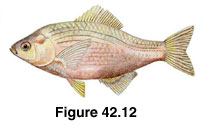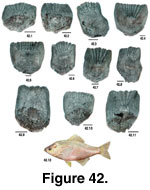 Description
Description
Brachyistius frenatus
(Kelp Perch)
(Other common names: Brown Sea-Perch, Brown Perch, Kelp Sea-Perch)
Figure 42.12
 Description
DescriptionLength: 20 cm.
Mouth: small, slightly pointed upward, terminal; upper jaw three-quarters of the way to the orbit; lower lip joined to jaw by frenum; teeth well developed.
Body: head slightly indented in profile at eye; lateral line parallels dorsal body contour; caudal peduncle is long and deep in comparison to head.
Color: variable; olive to brown to copper above the lateral line; sometimes blue spotted; bright below lateral line; fins pale or pinkish; may have black speckles on pectoral fins.
Depth: 27-30m.
Habitat: usually in areas with kelp beds (Macrocystis spp.).
Season: mating is in fall-winter; birth in late spring-summer.
Diet: crustaceans (e.g., amphipods, shrimp larvae).
Predators: Scombridae (Oliphant, 1962).
Distribution: Central Baja, California to southern British Columbia and southwest Vancouver Island.
 Scale Description
Scale DescriptionRelative Scale Size: moderate to large.
Position of Scales on Body: along the lateral line canal. Large scales are found along the anterior dorsal fin furrow. Scales also along peduncle at anterior part of the anal fin (Hart, 1973).
Overall Shape: there is less variability in shape compared to other species (e.g., White surfperch). The scales are generally square with a rounded posterior field. In some cases, the leading edge of the anterior field is not as wide as the lateral fields, which are long and give the appearance of being rectangular. Hart (1973) notes dark pigmentation under each scale.
Focus and Circuli: focus is slightly off center, being closest to the posterior field. The focus and surrounding circuli are circular and concentric with the outline of the scale. Circuli are generally continuous, but depending on the condition of the scale, there is some discontinuity in the anterior field. Circuli are broken and discontinuous in the posterior field.
Radii: numbers are variable and not diagnostic. Present only in the anterior field. The outer edge of the anterior field is scalloped.